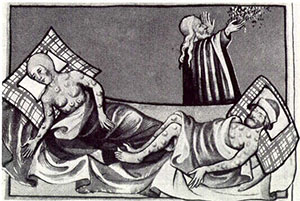
Illustration of the bubonic plague (1411).
In the 14th century, the knowledge of doctors and scholars concerning the causes, effects and therapies for the plague was still based on knowledge from the ancient world. Hippocrates, Galeno and other authors from late antiquity had used the theory of the humors to analyze the causes and evolution of illnesses. According to this theory, disturbances in health were nothing more than a bad mixing of the four humors: blood, phlegm, yellow bile and black bile. If black, cold and dry bile was prevalent, this brought about melancholy and an excess of blood, hot and humid humors, indicated the danger of putrefaction of internal organs, and Medieval doctors believed that this was the true process of plague contagion. It was believed that this putrefaction entered the organism through the air and food.
During the unforgettable plague epidemics that invaded the Italian peninsula beginning in 1348, two saints in particular were often invoked: Sebastian and Roch.
The first had been an official of the Dioclesian praetorian guard who, having secretly converted to Christianity, was exposed when he came to the defense of two persecuted Christians. As a result he was condemned to death by dart torture, but he miraculously survived the useless efforts of the armigers. Healed by a widow named Irene, he presented himself to the Emperor once again as a professor of faith, but this time he was beaten to death.
According to the Christian tradition, the wounds inflicted on Sebastian by the darts bore a resemblance to the bubos of the plague - people would invoke this saint in the hopes of being saved from the epidemic, just as he had been saved from the darts. Furthermore, there was an additional link between these weapons and the plague: the wrath of God was sometimes compared to arrows shot from a bow, and in Medieval times the spread of the disease was already seen as a manifestation of God's anger.
The other figure that was implored was Roch, born in France to a wealthy family from mercantile class at the end of the 13th century. According to the legend, when his parents died he donated all of his wealth to the poor and then, in 1348, moved to an Italy that was ravaged by the great plague. While caring for pilgrims, Roch himself contracted the disease. Tormented by a painful bubo in his inguinal region, he was kicked out by the other sick people when they grew tired of his complaints, so he took shelter in a cave to await his death. It was a dog that saved him. The little beast sensed his presence and his suffering and brought him a piece of bread every day until his owner discovered the Saint’s refuge and decided to take care of him.
Once he was cured, San Roch started his return voyage to France (continuing to help plague victims - this is why he is still remembered today), but soon became involved in the complicated political struggles of the time. Locked up in prison, five years passed before his miraculous powers were recognized, but when his cell was opened Roch was already dead..
Serena Nocentini